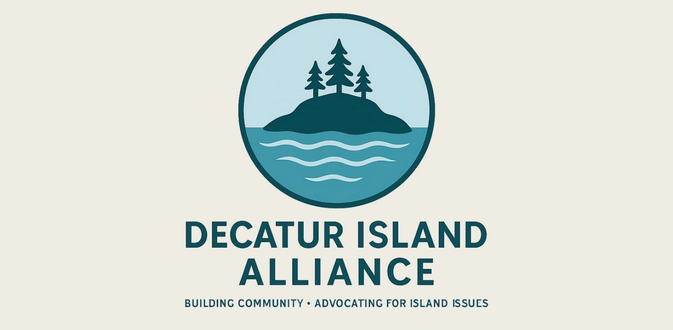The day was hot and the Town Hall was packed with Orcas citizens concerned about dwindling property rights and declining environmental conditions.
In the midst of this charged group at the Eastsound Fire Hall on Thursday, Sept. 8, County Council Members Richard Fralick and Patty Miller assisted County Planner Shireene Hale in the touchy subject of the Wetlands portion of the Critical Areas Ordinance (CAO) update, especially concerning “buffers” or zones around wetlands that must be development-free in order to build on other portions of private properties.
Fralick began the meeting with an overview of the process since 2006, when the ordinance update was due, according to the Growth Management Act (GMA) law.
He related that the work of a Citizens Advisory Committee to revise the law was affected by state law requiring that the “Best Available Science” (BAS) be used in making the changes to the CAO.
The County (staff, Council and the public) are now going through reviews of the proposed changes in the update, section by section. The timeline calls for a final review of the process and approval of the code changes in January, 2012.
Fralick emphasized the importance of citizen input with County staff, particularly at the “Town Hall” meetings. The next Orcas Town Hall meeting will be on Oct. 20 to consider the Fish and Wildlife Habitat section of the CAO.
Shireene Hale then reviewed the proposed staff changes to the wetlands section of the ordinance, after study by Dr. Paul Adamus, who was hired to review the BAS available.
“Site-specific” amendments were the main thrust of the changes to the existing laws, with formulas considering how environmentally-sensitive a “critical areas” is and how intensive the plans are for the development of the surrounding or adjacent property. Hale said these amendments:
- Dealt more fairly with property owners
- Created more options
- Reflected more of a tie between land and development conditions and regulations
Hale reviewed the proposed amendments to the current law:
- New definitions to go with proposed regulations
- Some requirements removed; “quite a few… such as the mitigation requirements,” said Hale;
- Changes to codes adopting maps
- Update to the county soil survey
- Addition of a new County wetlands map
Hale said that the amendments “consolidate and somewhat revise project approval procedures to improve wetlands.” Several appendices “that people could never find that weren’t part of code” were repealed; and instead the information is incorporated into the code “to simplify understanding,” Hale said.
Hale, Fralick and Miller then fielded questions from the audience.
Some asked questions relating distinctly to their own properties; Hale emphasized that the law is applicable only to new development; “Now the burden is on the property owner to prove an area is– or isn’t – wetland.”
Other attendees objected to an increased “layer” of regulation that inhibited the use and lowered the re-sale value of their land.
Deer Harbor resident Janet Alderton observed that, with the new formulas, many new developments would have smaller buffer areas around the critical, protected areas; especially if the development was less intensive.
Martha Farish said her comments were somewhat prompted by “nostalgia” and the effect the new laws and processes would have on the less-affluent islanders who would need to employ professional consultants to delineate their wetlands and their required buffers.
Realtor and Doe Bay resident Stu Stephens claimed that the ordinance restrictions, especially the buffer areas, had “killed” two prospective real estate sales.He said, ” I think the county has to be very careful about the impact in extending setbacks.”
Applause greeted comments from one attendee, an “absentee landlord,” who claimed, “My taxes have gone up by a factor of 100, restrictions get tighter and tighter; is there anyone in all of these taxpayer groups to take into consideration landowners’ property rights? We’re paying the taxes for all these wonderful groups to get together and figure out how to screw us.”
Fralick noted that property taxes are required to reflect fair market value: “If there are restrictions on property, then the assessor has to reduce the value appropriately.” He added that Orcas property values were last assessed in 2008, at the height of market value. Last year, County Assessor Charles Zalmanek went to Dept of Revenu and asked for a one year extension to three-year reassessment schedule. His request was granted, and now Orcas property holders will have to wait until 2012 for re-evaluations.
Fralick explained that in 2014, all counties in the state will be required to go to an annual re-assessment schedule, with physical assessments happening every six years. In 2014, information for individual property owners will be extrapolated for neighborhood and history of usage. He said, “I’m frustrated too, but that’s the law.”
Hale responded the “absentee landlord’s” comments, saying, “What we’re trying to figure out is how to prevent negative impacts [of development] on our neighbors and on shared resources.”
Hale summarized the proposed update revision as, “If it doesn’t say you can do it, then you can’t do it.” Olga resident and former County Commissioner John Evans strongly criticized this approach. “You are turning governance on its head.. If you have to go to council to ask permission to do something that isn’t listed in what you can do, that’s a big deal.”
Fralick responded: “You’ve got to give us credit….I’m approaching this as conscientiously as I know how.”
To questions regarding potential lawsuits resulting from the ordinance update, Patty Miller responded, “We’re trying to walk the right line. We have a state responsibility to protect waters… we may own land but not the resources affected by our development of our properties. Richard and I are committed to that and to come to right answers .
“We run risk of litigation whatever approach we take. We’re trying to strike the right balance and we want to hear from you.
“Again, these [critical areas] have been deemed public resources and the state has said we have a responsibility to protect them.”
Fralick added that anyone, property owner or not, can challenge the decisions and regulations made. He said, “We are trying to protect values and functions and property values. And yes, the county will have to find the funds to defend itself.”
There will be another meeting on the CAO update next Tuesday, Sept. 13 from 6 to 9 p.m, sponsored by the Eagle Forum. Miller and Fralick plan to be in attendance.
Looking ahead, the CAO update timeline calls for:
- Sept 16-28 Planning Commission – Wetlands
- Sept 13-Oct. 18 Frequently Flooded Geological Hazardous in front of County Council (Planning Commission will have already gone through it)
- Sept 27 Orcas field trip and council meet
- Oct 20 Town Hall Meeting to consider FWHCA
- Oct 21 Planning Commisson — FWHCA
- Oct 25 – Nov. Council Wetlands
- Nov 29 – Jan Council Fish and Wildlife Habitat Conservation areas
- Jan 10 Council Consistency Final Approval
(all dates subject to change)
**If you are reading theOrcasonian for free, thank your fellow islanders. If you would like to support theOrcasonian CLICK HERE to set your modestly-priced, voluntary subscription. Otherwise, no worries; we’re happy to share with you.**








The SJ County Planning Commission will have its first public hearing on the Wetland Critical Areas portion of the CAO this coming Friday, September the 16th, at the San Juan Island Grange, 152 First Street, in Friday Harbor. The hearing begins at 8:30am.
I strongly encourage folks who wish to have their concerns heard to attend the Planning Commission meeting, which will be accepting public testimony on the section. If you can not attend, the Planning Commission will also consider written or emailed comments up to the date of the hearing. If you are sending in written comments, if you can arrange to get them in a day or two before the hearing deadline, that will make it easier for County staff to make copies and distribute to the Planning Commission members.
The principal problem with this meeting is that a large part of it was the County planner telling us all how wonderful and easy life will be under the new CAO rules. We have repeatedly heard at these meetings how few properties will be affected and how few properties will have the greatest restrictions. Many of us who have read the proposals disagree with this estimate of potential impact. The questions from the audience at the latest Town Hall began to get at the heart of the matter, however, and the County Councilmembers conceded that issues exist and made clear that they wish to hear from homeowners and landowners. (The CAOs affect existing and proposed property uses. The fact that you already have a house does not mean that you are–no pun intended–“home free.”) Likewise, the Planning Commission members are eager to hear from us.
The County regulatory train is speeding down the tracks, and if Thursday’s Town Hall is any indication, homeowners in San Juan County will be run over unless some action is taken to respond.
Thanks to the Eagle Forum, there will be an opportunity for citizens and homeowners to hear the OTHER side of the story this coming Tuesday. The speakers will include Tim Blanchard (Common Sense Alliance volunteer) reviewing legal problems with the Critical Areas Ordinance changes being proposed; Ed Kilduff (Common Sense Alliance volunteer) discussing the proposals from the perspective of a professional engineer, and displaying MAPS of parcels likely affected, based on the County’s own GIS data; and John Evans (Common Sense Alliance volunteer) longtime Orcas resident and farmer, presenting history and perspective. The two Orcas Councilmembers will answer questions after these presentations.
I urge anyone concerned about the future of our island environment, economy, and community to attend. The County is now almost having 2-3 different hearings or meetings a week (Council, Planning Commission, etc.) on these topics with a completion date in January 2012. NOW is the time to learn what is proposed and make your views known.
Tuesday September 13th
Orcas Senior Center, 6:30 pm
With respect to the CAO, I was amazed to hear that County staff stated that the position of the county is “If it doesn’t say you can do it, then you can’t do it.” Such a position borders on infringement of the state’s manner of governance.
States may chose to operate as a “Free State” permitting local government to do anything that is not explicitly prohibited by the state constitution or legislature. By comparision, states operating under the Dillion Rule (see Federal Jurist John Forrest Dillon)prohibit local governments from doing anything unless explicitly allowed by the state constitution or legislature.
I am under the impression that Washington state operates as a Free State. Interestingly, San Juan County, a Washington state local government appears to want to operate as a Dillon Rule state – – perhaps in violation of Washington state practice?